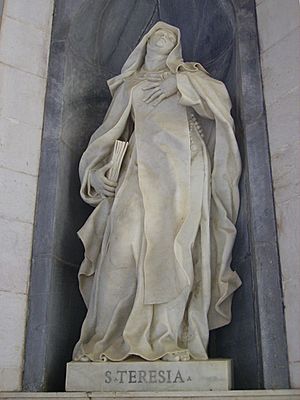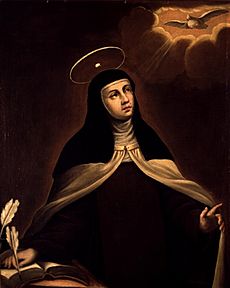Teresa of Ávila facts for kids
Quick facts for kids SaintTeresa of Ávila OCD |
|||||||||||||||
|---|---|---|---|---|---|---|---|---|---|---|---|---|---|---|---|
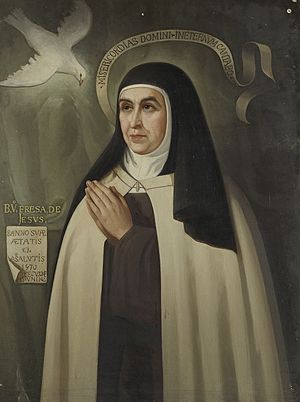
Saint Teresa of Ávila by Eduardo Balaca
|
|||||||||||||||
| Virgin, Doctor of the Church | |||||||||||||||
| Born | Teresa Sánchez de Cepeda y Ahumada 28 March 1515 Ávila, Crown of Castile (today Spain) |
||||||||||||||
| Died | 4 October 1582 (aged 67) Alba de Tormes, Salamanca, Crown of Castile (today Spain)
|
||||||||||||||
| Venerated in |
|
||||||||||||||
| Beatified | 24 April 1614, Rome by Pope Paul V | ||||||||||||||
| Canonized | 12 March 1622, Rome by Pope Gregory XV | ||||||||||||||
| Major shrine | Convent of the Annunciation, Alba de Tormes, Spain | ||||||||||||||
| Feast | 15 October | ||||||||||||||
| Attributes | Carmelite religious habit, biretta, quill, dove (as an attribute of the Holy Spirit), heart with a christogram | ||||||||||||||
| Patronage | Spain, sick people, people in religious orders, people ridiculed for their piety, lacemakers, Požega, Croatia, Talisay City, Cebu, Philippines | ||||||||||||||
| Controversy | Her reforms met with determined opposition and interest from the Spanish Inquisition, but no charges were laid against her. Her order split as a result. | ||||||||||||||
Teresa of Ávila, also known as Saint Teresa of Jesus, was a Spanish nun. She was a very important religious reformer and a Christian mystic. This means she had deep spiritual experiences and felt very close to God.
Teresa lived during a time called the Counter-Reformation. This was when the Catholic Church was making changes and reforms. Teresa became a key figure in renewing spiritual life and changing the Carmelite Order. She worked with another Carmelite friar, John of the Cross, to start the Discalced Carmelites. This new group followed stricter rules. In 1580, the Pope officially approved this new branch of the order.
Teresa wrote several important books about Christian mysticism and Christian meditation. Her most famous works are The Life of Teresa of Jesus, The Interior Castle, and The Way of Perfection. In her autobiography, she described how a person's soul can get closer to God. She talked about different stages of prayer, from simple mental prayer to a deep feeling of being one with God.
Forty years after she died, in 1622, Teresa was made a saint by Pope Gregory XV. Later, in 1970, Pope Paul VI gave her the special title of Doctor of the Church. This recognized her lasting spiritual impact on Catholicism. She was one of the first women to receive this honor.
Biography
Early life
Teresa Sánchez de Cepeda y Ahumada was born in 1515 in Ávila, Spain. Her family was wealthy. Her grandfather had been Jewish and was forced to convert to Christianity. He faced problems with the Spanish Inquisition, but her father became a successful wool merchant and a respected member of Christian society.
Teresa's mother, Beatriz de Ahumada y Cuevas, raised her to be a devoted Christian. When Teresa was seven, she loved reading stories about saints. She even ran away from home with her brother, Rodrigo. They wanted to become martyrs by fighting against the Moors. But their uncle found them just outside the town and brought them home.
When Teresa was eleven, her mother passed away. This made her very sad. She turned to the Virgin Mary for comfort, seeing Mary as her spiritual mother. Teresa also enjoyed popular stories about knights, fashion, and flowers. Later, she was sent to a school run by Augustinian nuns in Ávila.
Religious life
Becoming a nun
After school, Teresa wasn't sure if she wanted to become a nun. But after spending time with relatives, she decided to join a convent. In 1534, at age 20, she entered the Carmelite Convent of the Incarnation in Ávila. Her father was not happy about this choice.
At the convent, Teresa began reading books about contemplative prayer. These books taught her about "spiritual self-concentration and inner contemplation." She also read about how to examine her conscience and grow spiritually.
Teresa became very ill from her strict practices and spent almost a year in bed. She nearly died, but she believed she recovered thanks to Saint Joseph. After this, she started having powerful spiritual experiences. She felt very close to God, describing it as a "perfect union with God." She often cried tears of joy during these moments. She also began to understand the seriousness of sin and her need to fully surrender to God.
Around this time, she read Confessions by Augustine of Hippo. This book helped her realize that even great saints had struggled with sin. She found comfort in Augustine's story, writing that she "was very fond of St. Augustine [...] for he was a sinner too."
Powerful visions
Around 1556, some friends worried that her intense spiritual experiences might be from the devil, not from God. But her confessor, Francis Borgia, assured her that her thoughts were divinely inspired. On St. Peter's Day in 1559, Teresa became convinced that Jesus Christ had appeared to her in a visible but invisible form. These visions continued for more than two years.
One famous vision involved an angel piercing her heart with a golden spear. This experience, called the Transverberation, was so powerful that it inspired one of Bernini's most famous sculptures, the Ecstasy of Saint Teresa in Rome. This vision motivated her to live a life of suffering, like Jesus. She often said, "Lord, either let me suffer or let me die."
Teresa became well-known in her town for her spiritual experiences. Sometimes, she even reported levitation. This was embarrassing for her, and she would ask her sisters to hold her down. She wrote down almost everything that happened to her. This gives us a rare look into her religious life in the 16th century.
Reforming the Carmelite Order
Over time, Teresa became concerned about the relaxed rules at her convent. With 150 nuns, the strict cloister rules were not followed well. Many visitors, often important people, came and went, disturbing the quiet atmosphere needed for prayer. Teresa felt a strong desire to change this.
In 1560, she met a Franciscan priest, Peter of Alcantara, who became her spiritual guide. He encouraged her to found a "reformed" Carmelite convent. This new convent would follow stricter rules, correcting the laxity she saw. A wealthy friend, Guimara de Ulloa, provided the money for this project.
The new convent, called St. Joseph's (San José), opened in 1562. Its extreme poverty at first shocked the people of Ávila. But powerful supporters, including the local bishop, helped turn public opinion.
In March 1563, Teresa moved to the new convent. She received official approval for her main rules: absolute poverty and giving up all personal property. Her plan was to bring back the older, stricter monastic rules. This included weekly ceremonial flagellation and going barefoot, which is why her followers were called "Discalced" (meaning "shoeless") Carmelites. For the first five years, Teresa stayed mostly in seclusion, focusing on prayer and writing.
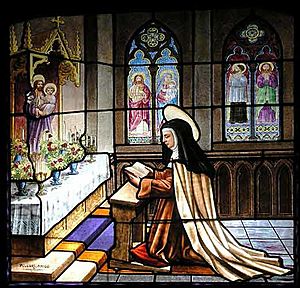
Journeys and new convents
In 1567, Teresa received permission from the Carmelite General to open more convents following her new rules. This meant many long and difficult journeys across Spain. She wrote about these travels in her book Libro de las Fundaciones. Between 1567 and 1571, she established reformed convents in several cities, including Medina del Campo, Valladolid, and Toledo.
Teresa also got permission to set up two monasteries for men who wanted to follow her reforms. She convinced two Carmelite friars, John of the Cross and Anthony of Jesus, to help her. In November 1568, they founded the first monastery for Discalced Carmelite brothers in Duruelo. Another friend, Jerónimo Gracián, also helped her establish more monasteries for men and women.
Challenges to her reforms
In 1576, some members of the old Carmelite order began to oppose Teresa and her reforms. They tried to stop her from founding more convents and told her to retire. She obeyed and went to St. Joseph's at Toledo. Her friends and supporters also faced attacks.
However, Teresa wrote letters to King Philip II of Spain, asking for help. In 1579, the cases against her and her friends were dropped. This allowed the reforms to continue. The Pope also allowed a special leader for the new Carmelite branch.
In her last three years, Teresa founded more convents in places like Palencia and Burgos. By the end of her life, she had founded seventeen convents for women and helped establish many monasteries for men.
Last days
Teresa became ill during a journey from Burgos to Alba de Tormes. She died in 1582. This was when Catholic Europe was changing from the old Julian calendar to the new Gregorian calendar. This change meant that the dates from 5–14 October were removed from the calendar. So, she died either on the night of 4 October or early on 15 October, which is now her feast day. Her last words were: "My Lord, it is time to move on. Well then, may your will be done. O my Lord and my Spouse, the hour that I have longed for has come. It is time to meet one another."
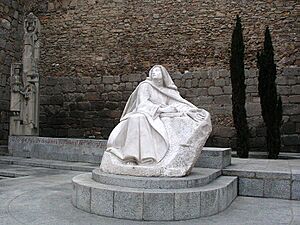
After her death
Holy relics
Teresa was buried in the Convent of the Annunciation in Alba de Tormes. Nine months later, her coffin was opened. Her body was found to be intact, meaning it had not decayed, but her clothes had rotted. Before reburying her, one of her hands was cut off and sent to Ávila. Her body was later moved back to Alba de Tormes by order of the Pope.
Parts of her body are kept as relics in different places:
- Rome – right foot and part of the upper jaw
- Lisbon – a hand
- Ronda, Spain – left eye and left hand (the latter was kept by Francisco Franco until his death)
- Museum of the Church of the Annunciation, Alba de Tormes – left arm and heart
- Church of Our Lady of Loreto, Paris, France – one finger
- Sanlúcar de Barrameda – one finger

Canonization
In 1622, forty years after her death, Pope Gregory XV made her a saint. In 1627, the Spanish parliament declared her a patroness of Spain. The University of Salamanca had given her the title "Doctor of the Church" during her lifetime. However, the official papal title of Doctor of the Church is given after death. Pope Paul VI finally gave her this title on September 27, 1970, along with Catherine of Siena. They were the first women to receive this honor. Teresa is known as the Doctor of Prayer. Her mystical writings influenced many thinkers in later centuries. In 1670, her coffin was covered in silver.
Teresa of Ávila is honored in the Church of England and the Episcopal Church on October 15.
Patron saint
In 1626, the Castilian parliament chose Teresa as a co-patron saint of Castile. In the 1620s, Spain debated whether James Matamoros or a combination of him and Saint Teresa should be the country's main patron saint. Teresa's supporters argued that Spain needed a modern patron saint to guide the nation through new challenges like Protestantism. Santiago's supporters eventually won, but Teresa of Ávila remained very popular locally. James the Great kept the title of patron saint for the Spanish people, and the Blessed Virgin Mary under the title Immaculate Conception became the sole patroness for the entire Spanish Kingdom.
Legacy of the Infant Jesus of Prague
Spanish nuns who started Carmelite convents in France brought with them a special devotion to the Infant Jesus. This devotion became very popular in France.
Although there's no written proof, tradition says that Teresa of Ávila owned the famous Infant Jesus of Prague statue. She is said to have given it to a noblewoman traveling to Prague. The statue's age matches Teresa's time. It was believed that Teresa carried a small statue of the Child Jesus wherever she went.
Writings
Teresa of Ávila wrote several important books that are still studied today.
Autobiography
Her autobiography, La Vida de la Santa Madre Teresa de Jesús (The Life of the Holy Mother Teresa of Jesus), was written between 1562 and 1565. It was published after her death. In this book, she shares her life story and her spiritual journey.
The Way of Perfection
The Way of Perfection (Spanish: Camino de Perfección) was published in 1566. Teresa called it a "living book." In it, she taught her nuns how to grow in prayer and Christian meditation. She explained why being a Carmelite was important and how to live a spiritual life. The book describes how to achieve spiritual perfection through prayer and its stages, leading to a deep union with God.
Interior Castle
The Interior Castle, also called The Mansions (Spanish: El Castillo Interior or Las Moradas), was written in 1577 and published in 1588. It describes the ideal journey of faith. Teresa compared the contemplative soul to a castle with seven inner rooms, or "mansions." Each mansion represents a step closer to God. She had a vision of the soul as a diamond-shaped castle with seven mansions. She saw this as the journey of faith through seven stages, ending with complete union with God.
Some scholars believe that the famous French philosopher René Descartes may have been influenced by Teresa's ideas. She wrote about the importance of thinking deeply for spiritual growth, years before Descartes wrote his Meditations on First Philosophy.
Other writings
- Relaciones (Relationships): This extends her autobiography, sharing her inner and outer experiences through letters.
- Her poems: Teresa wrote beautiful poems known for their tender feelings and thoughtful rhythm.
- Meditations on Song of Songs: Written in 1567 for the nuns in her convent.
- Conceptos del Amor ("Concepts of Love") and Exclamaciones.
- Las Cartas (Her Letters): There are 342 letters and 87 fragments of others that still exist. These letters give us insight into her life and thoughts.
Mysticism
The prayer Nada te turbe (Let nothing disturb you) is attributed to Teresa, having been found within her breviary:
Let nothing disturb you.
Let nothing make you afraid.
All things are passing.
God alone never changes.
Patience gains all things.
If you have God you will want for nothing.
God alone suffices.
Teresa's main focus in her spiritual writings was how the soul can get closer to God. She didn't write a strict system of prayer. Instead, she shared her own personal experiences. She believed that the "treasure of heaven" is hidden within our hearts, in the deepest part of the soul.
Stages of prayer
In her autobiography, Teresa described four stages of prayer, using the image of watering a garden:
- The first stage, Devotion of the Heart, involves mental prayer and meditation. It means turning your thoughts inward and thinking deeply about Christ's suffering.
- The second stage, Devotion of Peace, is when you start to give your will to God. You feel a sense of peace, even if your mind still gets distracted.
- The third stage, Devotion of Union, is a deeper, more joyful state. Your reason also becomes focused on God, and you feel a blissful peace and love for God.
- The fourth stage, Devotion of Ecstasy, is the deepest. You feel completely absorbed in God, and your senses may stop working. This state can last a while and is often followed by a feeling of weakness and tears. Teresa was even said to have levitated during Mass.
In her book Interior Castle, Teresa described seven "mansions" or dwelling places within the soul. Each mansion represents a step closer to God.
- The first three mansions involve active prayer and self-discipline. The soul starts seeking God's grace and tries to live a good life, avoiding sin and doing good deeds.
- The fourth and fifth mansions are where mystical prayer begins. The soul starts to experience a deeper, more quiet connection with God, feeling His presence.
- The sixth and seventh mansions are the highest stages. The sixth is like an engagement with God, where the soul feels a strong connection but still faces challenges. The seventh is like a "spiritual marriage" with God, where the soul achieves a clear and complete union with God.
Quotes
Teresa, who had visions of Jesus and Mary, strongly believed in the power of holy water. She claimed to have used it successfully to fight off evil spirits and temptations. She wrote: "I know from frequent experience that there is nothing which puts devils to flight better than holy water."
A modern prayer, Christ has no body but yours, is often linked to Teresa, but it is not found in her writings.
Portrayals
Teresa of Ávila has been shown in many forms of art and media.
Literature
- George Eliot compared a character in her novel Middlemarch (1871–1872) to St. Teresa.
- R. A. Lafferty was inspired by El Castillo Interior for his novel Fourth Mansions.
- Bárbara Mujica's novel Sister Teresa is based on Teresa's life.
Painting and sculpture
- Saint Teresa of Ávila's Vision of the Holy Spirit is a painting from 1612-1614 by Peter Paul Rubens.
- Another Rubens portrait of Teresa from 1615 is in Vienna.
- Saint Teresa inspired one of Bernini's most famous sculptures, The Ecstasy of St. Teresa (mid-17th century) in Rome.
- St. Teresa was painted in 1819–20 by François Gérard, a French painter.
Drama and film
- Teresa de Jesús (1984) is a Spanish TV mini-series about her life.
- Nigel Wingrove's 1989 short film Visions of Ecstasy was based on Teresa of Ávila.
- Paz Vega stars as Teresa in Teresa, el cuerpo de Cristo, a 2007 Spanish movie.
- Marian Álvarez plays the saint in Teresa, a 2015 Spanish television film.
- St. Teresa's sculpture, The Ecstasy of St. Teresa, is an important clue in the 2009 film Angels and Demons.
Music
- Marc-Antoine Charpentier composed two pieces of music for Saint Teresa's feast day.
- She is a main character in the opera Four Saints in Three Acts.
- "Theresa's Sound-World" by Sonic Youth is a song about Saint Teresa.
- Saint Teresa is a song on Joan Osborne's album Relish.
Images for kids
See also
 In Spanish: Teresa de Jesús para niños
In Spanish: Teresa de Jesús para niños
- Christian contemplation
- Carmelite Rule of St. Albert
- Discalced Carmelite nuns
- Doctors of the Church
- Founders of Catholic religious communities
- Incorrupt saints
- Spanish Roman Catholic saints


